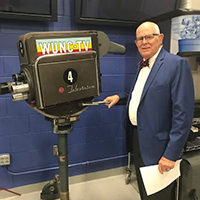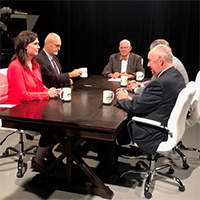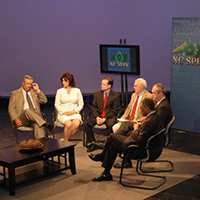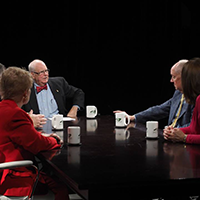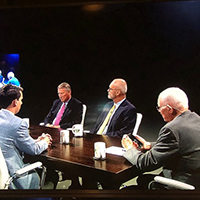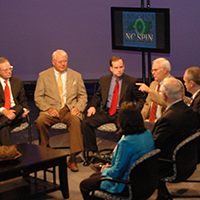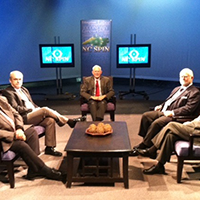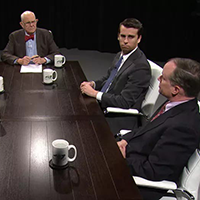What was missing at Superintendent Johnson's private education summit
Published February 21, 2019
by Billy Ball, NC Policy Watch, February 20, 2019.
There was much talk this week and last about state Superintendent Mark Johnson’s Tuesday night limelight, the “big” announcement you might have missed because you, like most of North Carolina, were not invited.
Public education advocates buzzed with speculation, or was that trepidation? Would the Koch brothers, billionaire union-busting philanthropists, bring their act to North Carolina? Who’s paying for Johnson’s invitation-only event at the Raleigh Convention Center? Has the superintendent found a way to coax more badly-needed infrastructure dollars out of a notoriously parsimonious state legislature?
Build-up’s fine, but like a good tennis coach will tell you, it’s all in the follow-through.
Time will tell whether Johnson intends to truly make a splash in North Carolina’s perennially pricey and perennially disappointing Read to Achieve initiative; whether he’s serious about investing in the state’s head-spinning, $8 billion school infrastructure tab; whether his pledge to push a five percent teacher pay raise makes little difference to state lawmakers; whether an educator-search dashboard for school systems will aid or abet teacher poaching from poorer districts; and whether there’s any substance to an image makeover for teachers sponsored by groups like Best N.C. and the Belk Foundation. Is it teachers, really, who need the image rehab anyway?
Put aside for a moment whether it’s appropriate to foist your public school agenda in a privately-funded soiree – it’s most assuredly not – Tuesday’s #NC2030 event was predictably pie-in-the-sky in tone and light on substantive details.
Democrats and public school advocates were, not surprisingly, caustic. “I think it has to be proposals that are bigger than a website and a dashboard,” state Rep. Graig Meyer, an Orange County Democrat, told Policy Watch Tuesday.
Some may criticize the superintendent, but legislative priorities – for better or for worse – are often frosting without the cake. Ultimately, it’s North Carolina lawmakers, and the Republican Party at their controls, that will do the baking.
Yet this was a stump speech, the 2020 election cycle come painfully early. The better part of two years remains in Johnson’s term, but the superintendent isn’t waiting.
He’s entitled to campaign – his political opponents likely aren’t cooling their heels either – but Johnson will hopefully bring the same zeal to this year’s budget negotiations.
In the first two years of his term, advocates, and even some conservative members of the State Board of Education rightfully skewered the superintendent for his relative silence while lawmakers pared the Department of Public Instruction down to the bone.
And last year, when 20,000 or more educators and advocates stormed Raleigh to demand greater education funding, Johnson decamped 100 miles east to, you can’t make this up, Craven County.
It’s not enough to sound the trumpet in February, on stage with a legion of donors, allies, and business interests. Public schools require his full-throated support in late spring, as lawmakers and the governor wage bruising battles over the state’s multi-billion dollar budget. Hash tags and splashy websites matter precious little in the appropriations committees, particularly in the Senate, where public school funding initiatives have too often gone to die in the last decade.
And the schools require more than a smattering of off-kilter, occasionally intriguing ideas that miss the breadth and depth of North Carolina’s public education crisis.
Johnson’s dinner was all sugary confection, but the nonpartisan Public School Forum of N.C. offered the meat and vegetables Tuesday in the release of its annual examination of local school funding.
The K-12 spending gap between affluent and poor counties is a canyon, the group reports. In the highest-spending county, Orange County, locals paid more than $5,000 per student. The lowest-spending county, Swain County – where more than 15 percent of the population lives below the poverty line – coughs up about $425 per student.
More galling, the gap between the ten highest spending counties and the ten lowest spending counties is the largest – about $2,500 per student – since the Forum began filing its sobering report in 1987, a reflection of the wide variance in local tax bases.
If the subject had been raised, surely dinner-goers at Johnson’s private bash would have gagged on dessert.
That funding gap should rile Johnson, the State Board of Education, Gov. Roy Cooper, Democrats, Republicans, independents, and everyone in between, because a “Lord of the Flies,” sink-or-swim public school system is no future dystopia. It’s a present-day dystopia.
As Greene County Schools Superintendent Patrick Miller explained Tuesday, a one-cent tax increase in his district yields only enough cash for about two teachers, but it raises millions in other parts of the state.
“You can see the gap in opportunities my children have versus children in more affluent places.”
And spending, despite what you may hear from arch-conservatives in the legislature – some of whom represent the poorest districts on the map – matters a great deal.
Top teachers and principals are lured elsewhere by high-dollar, local supplements; school facilities are feast or famine; classroom supplies are in scant supply, often paid for out-of-pocket by teachers; and students – particularly poor students and students of color – depart their school systems with markedly different experiences and, yes, outcomes.
Public School Forum chief Keith Poston says North Carolina needs a fundamental reappraisal of funding for low-wealth counties, an admirable, if remote, possibility in this legislature.
Even now, a joint legislative panel toils on a top-down, deconstruction of the state’s school-funding system, but Republicans on the committee bristle at the prospect of even a passing consideration of the adequacy or equity of state funding, while the courts engage in a Sisyphean grapple with a two-decade old school funding case that plumbed the depths of inequality in North Carolina school funding.
Sooner or later, whether it takes a drastic change of heart or, more likely, aggressive action by the courts, North Carolina will have to reckon with its towering equity problem.
It’s a problem not isolated to Greene County or Swain County; it’s a problem for us all. It’s a problem for the legislature, Gov. Cooper, and yes, Johnson, no matter the campaign placards.
Thousands may swim in Raleigh and Chapel Hill, but if thousands sink in rural North Carolina, the state and its leaders are sunk too.
